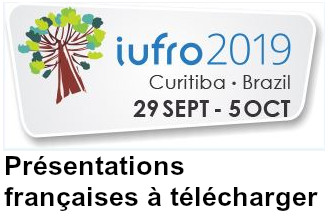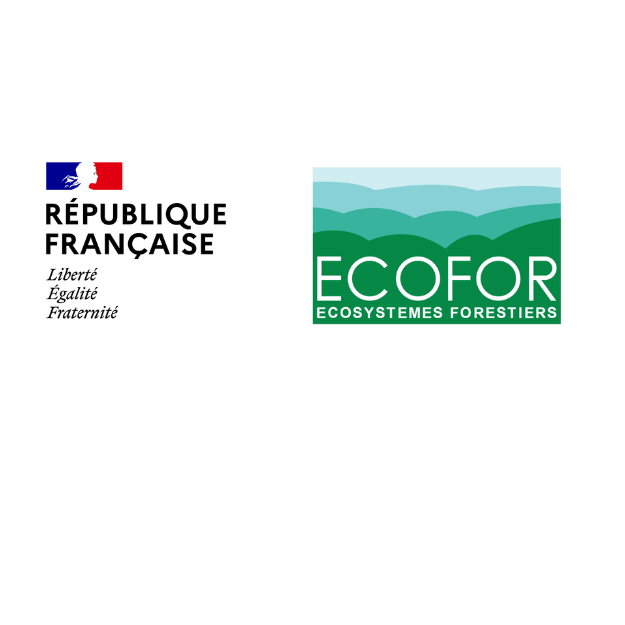

Programme
Accéder aux interventions françaises
B1b : Management options to increase the drought-tolerance of forests
9:45-10:00 | B1b : Relative importance of climate, thinning and light use efficiency on drought vulnerability of Norway spruce and silver fir in central European mixed forests, Alessandra Bottero1,David I. Forrester1,2,Maxime Cailleret3,Ulrich Kohnle4,Arun K. Bose1,Jürgen Bauhus2,Harald Bugmann5,Matthias Cuntz6,Arthur Gessler1,Loïc Gillerot5,Marc Hanewinkel7,Mathieu Lévesque5,Julien Sainte-Marie6,Julia Schwarz2,Rasoul Yousepfour7,Juan Carlos Zamora7,Andreas Rigling1
1. Swiss Federal Research Institute WSL, Birmensdorf, Switzerland. 2. Chair of Silviculture, University of Freiburg, Freiburg, Germany. 3. IRSTEA Aix-en-Provence, Aix-en-Provence, France. 4. Forest Research Institute of Baden-Württemberg FVA, Freiburg, Germany. 5. Chair of Forest Ecology, ETH Zürich, Zürich, Switzerland. 6. INRA, Université de Lorraine, AgroParisTech, UMR Silva, Nancy, France. 7. Chair of Forestry Economics and Forest Planning, University of Freiburg, Freiburg, Germany.
B1c : Managing for adaptation : increasing resistance, resilience and transformative capacity
16:12-16:26 | B1c : Why foresters do not adapt their forests to climate change while they know its impacts? The project “Adaptation measures to climate change by foresters” in France, Julie Thomas1,2,Annabelle Amm3
1. INRA, Nancy, France. 2. Centre National de la propriété forestière, Paris, France. 3. GIP ECOFOR, Paris, France.
B1d: Resilience of Managed Tropical Forests – It is time for silviculture
8:45-9:00 | B1d : The main challenges of sustainable forest management in the Amazon: Why sustainable forest management in the Amazon should be reinforced?, Plinio Sist1,Lucas Mazzei2,Camille Piponiot1,Bruno Herault1,Geraldine Derroire3,Euridice Honorio4,Milton Kanashiro2,Marcus d’Oliveira5,Marielos Peña-Claros6,Ken Rodney7,Verginia Wortel8,Alexander Shenkin9
1. Cirad-Forests & Societies, Montpellier, France. 2. Embrapa, Belém, Brazil. 3. Cirad-Ecofog, Kourou, French-Guiana. 4. IIAP, Iquitos, Peru. 5. Embrapa, Brasilia, Brazil. 6. Wageningen University, Wageningen, Netherlands. 7. IWOKRAMA, IWOKRAMA, Guyana. 8. CELOS, Paramaribo, Suriname. 9. Oxford, London, United Kingdom.
Subplenary B2a: Trees on the move: range shifts, potential for genetic adaptation and assisted migration
14:18-14:31 | B2a : Negative selection and polygenic adaptation in maritime pine, Marina de Miguel1,Isabel Rodríguez-Quilón2,Agathe Hurel1,Juan-Pablo Jaramillo-Correa3,Myriam Heuertz1,Delphine Grivet2,Giovanni Vendramin4,Christophe Plomion1,Ricardo Alia2,Andrew Eckert5,Santiago Gonzalez-Martinez1
1. BIOGECO, INRA, Univ. Bordeaux, Cestas, France. 2. Department of Forest Ecology and Genetics, Forest Research Centre, INIA, Madrid, Spain. 3. Department of Evolutionary Ecology, Institute of Ecology, Universidad Nacional Autónoma de México, Mexico City, Mexico. 4. Institute of Biosciences and Bioresources, Division of Florence, National Research Council, Sesto Fiorentino , Italy. 5. Department of Biology, Virginia Commonwealth University, Richmond, USA.
B2d : Wood and tree-ring studies of forest adaptation to climate change ; implications for wood production
Introduction : ChairDr Alejandro Martinez Meier, MC Paulina Puchi, Dr Philippe Rozenberg, MC Margarita Escobar Sandoval
16:00-16:15 | B2d : Impact of drought on Eucalyptus wood chemistry by near infrared hyperspectral imaging, Gilles Chaix1,2,Mariana Pires Franco2,Roger Chambi Legoas2,Nathalie Gorretta3,Celio Pasquini4,Cristiane Vidal4,Jean-Michel Roger3,Mario Tomazello-Filho2
1. Cirad, Montpellier Cedex 9, France. 2. ESALQ, Piracicaba, Brazil. 3. IRSTEA, Montpellier, France. 4. Unicamp, Campinas, Brazil.
16:15-16:30 | B2d : Spatial variation of wood density for Eucalyptus grandis by near infrared hyperspectral imaging combined with X-ray analysis, Roger Chambi-Legoas1,Mario Tomazello-Filho2,Nathalie Gorretta3,Celio Pasquini4,Cristiane Vidal4,Jean-Michel Roger3,Gilles Chaix2,5
1. Departamento de Ciências Florestais, Escola Superior de Agricultura Luiz de Queiroz, Universidade de São Paulo, Montpellier, Brazil. 2. Departamento de Ciências Florestais, Escola Superior de Agricultura Luiz de Queiroz, Universidade de São Paulo, Piracicaba, Brazil. 3. IRSTEA, UMR ITAP, Montpellier, France. 4. UNICAMP, Department of Analytical Chemistry, Campinas, Brazil. 5. CIRAD, UMR AGAP, Univ Montpellier, INRA, Montpellier SupAgro, Montpellier, France.
B2r – Poster : Effects of potassium/sodium fertilization and water availability on wood properties of Eucalyptus grandis trees
Roger Chambi-Legoas1, Gilles Chaix2,1, Mario Tomazello-Filho11Departamento de Ciências Florestais, Escola Superior de Agricultura Luis de Queiroz, Universidade de São Paulo, Piracicaba, Brazil. 2CIRAD, UMR AGAP, Montpellier, France
Subplenary B4a: Climate smart forestry or how to integrate adaptation, mitigation and sustainable forest management
Chair : Prof Donald Hodges, Dr Jean-Luc Peyron
B4g : Long-term forest monitoring networks for evaluating responses to environmental change – I
16:57-17:09 | B4g : Optimising observation networks for the early detection and unequivocal attribution of environmental effects on European forests, Virginie Moreaux1,2,Dario Papale3,4,Bert Gielen5,6,Denis Loustau1,7
1. INRA, UMR ISPA, Villenave d’Ornon, France. 2. UMR IGE, , Grenoble, France. 3. University of Tuscia, Viterbo, Italy. 4. ICOS Ecosystem Thematic Centre, Viterbo, Italy. 5. University of Antwerpen, Antwerpen, Belgium. 6. ICOS Ecosystem Thematic Centre, Antwerpen, Belgium. 7. ICOS Ecosystem Thematic Centre, Villenave d’Ornon, France.
B4i : Long-term forest monitoring networks for evaluating responses to environmental change – II
9:25-9:35 | B4l : Estimating the climate services value for forest management: the case of drought for maritime Pine plantations in South-West, France Sylvain Caurla1,Antonello Lobianco2
1. INRA, Nancy, France. 2. AgroParisTech, Nancy, France.
15:45-15:57 | B4i : The Tropical managed Forests Observatory: a research network addressing the future of tropical logged forests, Plinio Sist Cirad-Forests & Societies, Montpellier, France.
16:21-16:33 | B4i : Main sources of uncertainty in large-scale assessments of ozone effects on forest growth, Maxime Cailleret1,2,Matthias Haeni1,Marco Ferretti1,Leonie Schoenbeck1,David Simpson3,4,Marcus Schaub1
1. WSL, Birmensdorf, Switzerland. 2. IRSTEA, Aix-en-Provence, France. 3. Norwegian Meteorological Institute, Oslo, Norway. 4. Chalmers University of Technology, Gothenburg, Sweden.
17:15-17:18 | B4i : Analysis and modelling of the wood density variability of the French forest species for the assessment of the forest biomass under climatic change , Jean-Michel LEBAN1,Baptiste KERFRIDEN1,jean-daniel Bontemps21. INRA, Champenoux, France. 2. IGN, Nancy, France.
B4l: Climate smart forestry or how to integrate adaptation, mitigation and sustainable forest management
B4q – Poster : Towards a global network of tree-ring based information on tree mortality
Maxime Cailleret1,2, Christof Bigler3, Harald Bugmann3, Vasilis Dakos4, Lucia De Soto5,6, Arthur Gessler2, Steven Jansen7, Elisabeth Robert8, Jordi Martínez-Viilalta8,91IRSTEA, Aix-en-Provence, France. 2WSL, Birmensdorf, Switzerland. 3ETH Zürich, Zürich, Switzerland. 4ISEM, CNRS, Montpellier, France. 5EEZA-CSIC, Almeria, Spain. 6University of Coimbra, Coimbra, Portugal. 7Ulm University, Ulm, Germany. 8CREAF, Cerdanyola del Vallès, Spain. 9Universitat Autonoma de Barcelona, Cerdanyola del Vallès, Spain
B5b : Innovative wood protection and durability strategies to mitigate climate change in the tropics and warm temperate climes
8:30-8:45 | B5b : From fungal detoxification systems to wood durability, Eric Gelhaye1,Melanie Rouhier2,Rodnay Sormani2,Thomas Perrot2
1. INRA, Nancy, France. 2. Université de Lorraine, Nancy, France.
9:15-9:30 | B5b : Evaluation of Furfural/Urea complexes to improve properties of commercial birch wood (Betula sp.), Davood Efhamisisi1,Marie-France Thevenon2,3,Marzieh Sharifat1,Asghar Taromian1,Mehdi Jonoobi1
1. Department of Wood and Paper Sciences and Technology, Faculty of Natural Resources, University of Tehran , Tehran, Iran, Islamic Republic of. 2. Wood Preservation Laboratory, CIRAD, UR BIOWooEB, Montpellier, France. 3. BIOWooEB, Univ. Montpellier, CIRAD, Montpellier, France.
9:30-9:45 | B5b : Valorization of pyrolysis by-products from sugar cane bagasse for the protection of biomaterials, Febrina Dellarose Boer1,2,Marie France Thevenon1,2,Jean-Michel Commandré1,2,Mériem Fournier3
1. CIRAD, UR BIOWooEB, Montpellier, France. 2. BIOWooEB, Univ. Montpellier, CIRAD, Montpellier, France. 3. LERFOB, AgroParisTech, INRA, Nancy, France.
Les forêts et produits forestiers pour un futur plus vert (C)
C1v -Poster : Are mixtures a good option to reduce drought-induced risk of forest decline? Carbon accounting and economic approach
Sandrine Brèteau-Amores1, Mathieu Fortin2, Pablo Andrés-Domenech3, Nathalie Bréda41INRA – BETA, Nancy, France. 2Canadian Forest Service, Ottawa, Canada. 3AgroParisTech – BETA, Nancy, France. 4INRA – SILVA, Nancy, France
C2b: Tolerance of Eucalyptus clones to abiotic and biotic stresses: Building the foundation for the future plantations
8:40-8:50 | C2b : Full-rotation carbon, water and energy fluxes in a tropical eucalypt plantation, Yann Nouvellon1,José-Luiz Stape2,3,Guerric le Maire1,4,Jean-Marc Bonnefond5,Joannès Guillemot1,6,Mathias Christina1,Jean-Pierre Bouillet1,6,Otávio Campoe3,7,Jean-Paul Laclau1,3
1. Cirad, UMR Eco&Sols, Montpellier, France. 2. Suzano Forestry Technology, Itapetininga, Brazil. 3. UNESP, Botucatu, Brazil. 4. UNICAMP, NIPE, Campinas, Brazil. 5. INRA, Bordeaux, France. 6. USP/ESALQ, Piracicaba, Brazil. 7. UFSC, Curitibanos, Brazil.
8:50-9:00 | C2b : Light use efficiency and productivity of 16 genotypes of Eucalyptus along a 6-year rotation in BrazilGuerric le Maire1,2,Joannès Guillemot1,3,Otávio Campoe4,5,José-Luiz Stape5,6,Jean-Paul Laclau1,Yann Nouvellon1
1. CIRAD, Montpellier, France. 2. UNICAMP, Campinas, Brazil. 3. ESALQ-USP, Piracicaba, Brazil. 4. UFSC, Curitibanos, Brazil. 5. UNESP, Botucatu, Brazil. 6. Suzano Pulp and Paper, Suzano, Brazil.
C2c: Towards Sustainable Development of the Global Teak Sector in a Changing World
C3r – Poster : Discriminação de espécies de madeiras da floresta Amazônica de Paragominas, estado do Pará, Brasil, pela aplicação da espectroscopia no infravermelho próximo (NIRS)
Caroline Américo Da Silva1,2, Alinne Santos Da Silva1, Mario Tomazello-Filho1, Edson Vidal1, Gilles Chaix3,11University of São Paulo, ESALQ, Department of Forest Sciences, Piracicaba, Brazil. 2Klabin S.A., São Paulo, Brazil. 3UMR AGAP, CIRAD, Univ Montpellier, Montpellier, France
C4h: From long-term monitoring and time series to foresight analyses and projections
Chair : Dr Jean-Luc Peyron
C5a: Characterizing Properties of Plantation Wood for Optimal Value
17:00-17:10 | C5a : Construção de modelos preditivos da densidade básica da madeira de Eucalyptus grandis W. Hill ex Maiden pela espectroscopia no infravermelho próximo (NIRS), Caroline Américo Da Silva1,2,Mariana Pires Franco1,Roger Chambi Legoas1,Lucas Sene Oste1,Samara Franzol1,Mario Tomazello-Filho1,Gilles Chaix1,3
1. University of São Paulo, ESALQ, Department of Forest Sciences, Piracicaba, Brazil. 2. Klabin S.A., São Paulo, Brazil. 3. UMR AGAP, CIRAD, Univ Montpellier, Montpellier, France.
C5f: Quality requirements of forest biomass for biorefinery
16:45-17:00 | C5f : Free formaldehyde phenolic resins for a potential use in adhesives formulation, wood coating and porous materials production, Hamed Issaoui1,Pedro Luis de Hoyos Martínez1,2,Jalel Labidi2,Fatima Charrier – El Bouhtoury1
1. University of Pau and Pays de l’Adour, IPREM, UMR 5254 CNRS/UPPA, IUT des Pays de l’Adour, Mont de Marsan, France. 2. Chemical and Environmental Engineering department, University of the Basque Country, Donostia-San Sebastian, Spain.
C7d: Will active restoration of Secondary and Degraded Forests (SDFs) help to address sustainably the gap between wood demand and supply?
15:30-15:45 | C7d : Tapping the potential of restoring disturbed tropical forests, Plinio SistMontpellier, France.
15:45-15:57 | C7d : Phenomenological modelling scenario of future wood demand by 2050, Jean-Marc Roda1,2,Ainuddin Nuruddin2,Chu Lee Ong2,Omar Hishamudin2,Philippe Guizol3
1. CIRAD, Serdang, Malaysia. 2. Universiti Putra Malaysia, Serdang, Malaysia. 3. CIRAD, Montpellier, France.
C7d – Poster : Different contexts, same concerns ? Wood gap and forest restoration in Indonesia and Cameroon.
Philippe Guizol1,2, Liboum Mbonayem2, Abdon Awono2, Jean Marc Roda1, Richard Eba’a Atyi21CIRAD, Montpellier, France. 2CIFOR, Yaoundé, Cameroon
C9e: Traditional, emerging and new forest products in a bioeconomy – advances and applications in modelling the market potentials and sectoral impacts
17:10-17:30 | C9e : From early attempts to recent trends: economic simulation as an investigation tool for the forest sector, Sylvain Caurla1,Miguel Rivière2
1. INRA, Nancy, France. 2. AgroParisTech, Nancy, France.
Biodiversité, services écosystémiques et invasions biologiques (D)
D1c: Disturbance, ecosystem memory, risk and forest management in a changing socio-ecological environment’
15:30-15:45 | D1c : Forest owner’s preferences towards risk and uncertainty, and adaptation decisions towards climate change, Marielle Brunette1,Marc Hanewinkel2,Rasoul Yousefpour2
1. INRA, Nancy, France. 2. University of freiburg, Freiburg, Germany.
16:15-16:23 | D1c : Species mixture vs. age mixture: how to conciliate wood production and carbon sequestration objectives under drought and windstorm risks in forest, Sandrine Brèteau-Amores1,Rasoul Yousefpour2,Marc Hanewinkel2,Mathieu Fortin3
1. INRA – BETA, Nancy, France. 2. University of Freiburg, Freiburg-in-Breisgau, Germany. 3. Canadian Forest Service, Ottawa, Canada.
16:38-16:45 | D1c : After the catastrophe. Turning off or speeding up? How French forest owners cope with climatic extreme events, Philippe Deuffic & Vincent Banos (IRSTEA, Cestas, France).
D5c: Productive Conservation: more sustainable systems
8:30-8:40 | D5c : Social and economic impacts of gem harvesting in resinous silviculture, Henri HUSSON1,Javier Calvo2
1. Centre régional de la Propriété forestière de Nouvelle-Aquitaine, Bordeaux, France. 2. CESFOR, madrid, Spain.
D7m: Forest health challenges from globalisation and climate change
16:48-17:01 | D7m : What economics can tell us about pest in forest?, Montagne-Huck Claire & Brunette Marielle (INRA, BETA, Nancy, France).
Subplenary D8a: Forest Biodiversity in the framework of global change and the role of Landscape
Introcuction : Chair : João Azevedo, Dr Sandra Luque
D8c: The role of tree related microhabitats in forest ecosystems
8:30-8:43 | D8c : Tree-related microhabitat spatial patterns in European beech-dominated forests, Laurent Larrieu1,2,Benoit Courbaud3,Michel Goulard1,Wilfried Heinz1,Daniel Kraus4,Thibault Lachat5,Sylvie Ladet1,Fabien Laroche6,Jörg Müller7,8,Yoan Paillet6,Andreas Schuck9,Jonas Stillhard10,Miroslav Svoboda11
1. DYNAFOR, Université de Toulouse, INRA, Toulouse, France. 2. CRPF Occitanie, Tarbes, France. 3. University Grenoble Alpes, Irstea, LESSEM, Grenoble, France. 4. Chair of Silviculture, Freiburg University, Freiburg, Germany. 5. Bern University of Applied Sciences, School of Agricultural, Forest and Food Sciences HAFL, Bern, Switzerland. 6. Irstea, UR EFNO, Nogent sur Vernisson, France. 7. Bavarian Forest National Park, Grafenau, Germany. 8. University of Würzburg, Würzburg, Germany. 9. European Forest Institute, Bonn, Germany. 10. Swiss Federal Research Institute WSL, Birmensdorf, Switzerland. 11. Czech University of Life Sciences (CULS), Praha, Czech Republic.
8:43-8:56 | D8c : Modelling the occurrence of tree-related microhabitats in managed uneven-aged forest stands over time, Benoit COURBAUD1,Laurent LARRIEU2,François DE COLIGNY3,Daniel KRAUS4,Thibault LACHAT5,6,Jörg MULLER7,8,Yoan PAILLET9,Andreas SCHUCK10,Jonas STILHARD6,Miroslav SVOBODA11
1. Univ. Grenoble Alpes, Irstea, LESSEM, Grenoble, France. 2. INRA, UMR DYNAFOR & CRPFOcc, Toulouse, France. 3. AMAP, INRA, CIRAD, CNRS, IRD, Univ Montpellier, Montpellier, France. 4. Integrate Foundation, Bonn, Germany. 5. Bern University of Applied Sciences, School of Agricultural, Forest and Food Sciences HAFL, Bern, Switzerland. 6. Swiss Federal Research Institute WSL, Birmensdorf, Switzerland. 7. Bavarian Forest National Park , Grafenau, Germany. 8. University of Würzburg, Würzburg, Germany. 9. Irstea, UR EFNO, Nogent sur Vernisson, France. 10. European Forest Institute, Bonn, Germany. 11. Czech University of Life Sciences, Prague, Czech Republic.
9:35-9:48 | D8c : Does forest biodiversity respond to pulses of saproxylic microhabitats induced by tree dieback: a case study in mountain French silver fir forests, Christophe Bouget1,Laurent Larrieu2,Laurent Burnel2,Lopez-Vaamonde Carlos3,Moliard Carl1,Jerome Molina2,Guillem Parmain1,Grégory Sajdak4,Lucas Sire5,Jerome Willm2
1. Irstea, Nogent-sur-Vernisson, France. 2. INRA, Toulouse, France. 3. INRA, Orleans, France. 4. CRPF, Toulouse, France. 5. IRBI, Tours, France.
10:14-10:20 | D8c : How to deal with tree microhabitats in daily forest management? Different tools to implement conservation aspects related to microhabitats into forestry, Frank Krumm1,Rita Bütler2,Laurent Larrieu3,Thibault Lachat4
1. Swiss Federal Institute for Forest, Snow and Landscape Research WSL, Birmensdorf, Switzerland. 2. Swiss Federal Institute for Forest, Snow and Landscape Research WSL, Lausanne, Switzerland. 3. INRA, Toulouse, France. 4. Bern University of applied sciences, Zollikofen, Switzerland.
D8e: Improving conservation targets for forest biodiversity: towards operational solutions from remote sensing technology
Introduction : Chair : Dr Sandra Luque, Petteri Vihervaara
17:18-17:30 | D8e : Improving biodiversity monitoring using satellite remote sensing derived indicators, Sandra LuqueIrstea UMR TETIS, Montpellier, France.
D8q – Poster : Tree-related microhabitat co-occurrences: towards easier monitoring?
Laurent Larrieu1,2, Alain Cabanettes1, Benoit Courbaud3, Michel Goulard1, Daniel Kraus4, Thibault Lachat5, Jörg Müller6,7, Yoan Paillet8, Andreas Schuck9, Jonas Stillhard10, Miroslav Svoboda111DYNAFOR, Université de Toulouse, INRA, Toulouse, France. 2CRPF Occitanie, Tarbes, France. 3University Grenoble Alpes, Irstea, LESSEM, Grenoble, France. 4Chair of Silviculture, Freiburg University, Freiburg, Germany. 5Bern University of Applied Sciences, School of Agricultural, Forest and Food Sciences HAFL, Bern, Switzerland. 6Bavarian Forest National Park, Grafenau, Germany. 7University of Würzburg, Würzburg, Germany. 8Irstea, UR EFNO, Nogent sur Vernisson, France. 9European Forest Institute, Bonn, Germany. 10Swiss Federal Research Institute WSL, Birmensdorf, Switzerland. 11Czech University of Life Sciences, Praha, Czech Republic
Interactions entre les forêts, le sol et l’eau (E)
E8f: Current understanding and future challenges for forest research after the two nuclear accidents of Chernobyl and Fukushima – I
10:10-10:25 | E8f : How knowledge on K and 133Cs biocycling can be used to estimate 137Cs root uptake in Japanese cedar stands contaminated by the Fukushima fallouts, Pierre Hurtevent1,Frederic Coppin1,Marc-André Gonze1,Philippe Calmon1,Kenji Nanba2,Yuichi Onda3,Yves Thiry4
1. IRSN, Saint-Paul-Lez-Durance, France. 2. IER/Fukushima University, Fukushima, Japan. 3. CRIED/University of Tsukuba, Tsukuba, Japan. 4. ANDRA, Chatenay-Malabry, France.
10:25-10:40 | E8f : Process-based modelling of the short and long-term dynamics of radiocesium in Fukushima coniferous forests, Marc-André Gonze,Philippe Calmon,Pierre Hurtevent,Frédéric Coppin,Valérie Nicoulaud (IRSN, Saint-Paul lez Durance, France).
E8p – Poster : Microbial enzymatic activities and community-level physiological profiles (CLPP) in subsoil layers are altered by harvest residue management practices in a tropical Eucalyptus grandis plantation
François Maillard1, Valentin Leduc1, Cyrille Bach1, José Léonardo de Moraes Gonçalves2, Fernando Dini Andreote3, Laurent Saint-André4, Jean-Paul Laclau5, Marc Buée1, Agnès Robin5,31Université de Lorraine, INRA, IAM, Nancy, France. 2ESALQ, Univ São Paulo, pi, Brazil. 3ESALQ, Univ São Paulo, Piracicaba, Brazil. 4INRA UR 1138 Biogéochimie des Ecosystèmes Forestiers, Nancy, France. 5CIRAD, UMR Eco&Sols, Montpellier, France
E8p – Poster : N2 fixing trees (Acacia mangium) introduce in eucalypt plantations modify rapidly the pools of organic P and low-molecular-weight organic acids (LMWOAs) in tropical soils contrasted for their C/P stoichiometry
Kittima Waithaisong1,2, Agnès Robin3,4, Louis Mareschal3, Jean-Pierre Bouillet3, Jean-Paul Laclau3, José Léonardo de Moraes Gonçalves4, Manon Villeneuve5, Philippe Deleporte3, Claude Plassard11INRA/ UMR Eco&Sols, Montpellier, France. 2Department of Microbiology, Faculty of Science Silpakorn University-Sanam Chandra Palace Campus , Nakhon Pathom , Thailand. 3CIRAD, UMR Eco&Sols, Montpellier, France. 4ESALQ, Univ São Paulo, Piracicaba, Brazil. 5IRD, UMR Eco&Sols, Montpellier, France
Communiquer, éduquer, réseauter et publier (F)
F9b: Delivering and communicating forest science for people and a greener future
15:35-15:45 | F9b : A link between Foresters and the general public: Forest and wood in 100 questions, Jean-Luc PEYRON1,2,Yves BIROT2,Bernard ROMAN-AMAT2
1. GIP ECOFOR, PARIS, France. 2. Académie d’agriculture de France, PARIS, France.
F9c: Forest Science editing in the context of Open Science: what changes are ahead for us?
9:05-9:20 | F9c : The opportunities offered by open science to forest and wood science journal editors.Erwin Dreyer1,Aurore Coince1,Odile Hologne2
1. Inra, Champenoux, France. 2. Inra, Versailles, France.
